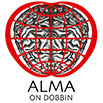
The Alma On Dobbin Collection consists of art works donated to the foundation by artists and collectors.
Alma is currently working towards the establishment of a Center for Hungarian Art, which will house, exhibit, and promote the study of Hungarian visual culture.
This collection was begun by Dr. Miklós Müller, while he was a university student in Budapest in the late 1940s. He met, and later married, Noemi Mezei, the daughter of Árpad Mezei, who was a founding member of the European School, Hungary’s post-Second World War avant-garde group. The young couple were given gifts of art by several of the Modernist artists in the European School, and they began to assemble a collection, which they brought with them to the United States when they immigrated in the 1960s. The couple separated, and Miklós Müller’s share of the collection languished in storage until he met and married Dr. Jan S. Keithly in 1973. She encouraged him to frame and display many of the works, and then they jointly built the collection for many years. As travel to and from Hungary eased more and more, they were able to visit Hungary, meet the generations of artists that had sprung up from the late 1960s onward, and collect their work. Also, Hungarian artists visiting New York would get in touch, and often stay at Miklós Müller’s Manhattan apartment. Some artists, like the European School sculptor József Jakovits, who settled in New York City in 1966, even used the apartment as a studio. Through the couple’s enduring friendships with several artists—such as Jakovits—they acquired numerous works from particular artists, often with personal inscriptions, and also built up an archive of correspondence and documentation. Portions of the Müller-Keithly Collection donated to Alma, including the largest holdings in the United States of the work of József Jakovits, are available through Alma’s online database. In due course, related publications, documentation, and ephemera will be cataloged and made available online.
© ALMA 2014